
Biscayne celebrates Year of Reef
HOMESTEAD, Fla.— Florida is synonymous with gorgeous sunny weather, beautiful beaches and crystalline waters. When the warm rays kiss the skin, it inspires people to embrace what nature has to offer, making the sunshine state a hotspot for water activities, including snorkeling and diving, which allow visitors and natives to enjoy the array of aquatic wildlife.
Biscayne National Park is a wonderful place to become one with the underworld and what a better time to visit the park since the year 2008 has been globally recognized as the International Year of the Reef.
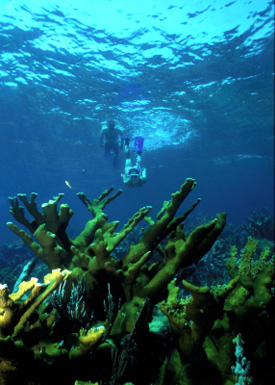 |
Divers enjoy the coral ecosystem at Biscayne National Park (Photo courtesy of the National Park Service). |
Biscayne National Park does not only provide its visitors with activities that can help enhance their knowledge on the marine ecosystems, but also it remains the largest marine park in the United States national park system.
“I have been diving these waters my entire life, and being able to become a part of the coral underworld is an indescribable experience. It upsets me to think that someday, my grandchildren may not be given the chance to see nature in its splendor,” said Florida native and avid diver Casey Velazquez.
| Elkhorn coral are abundant in Biscayne National Park’s warm waters (Photo courtesy of the National Park Service). |
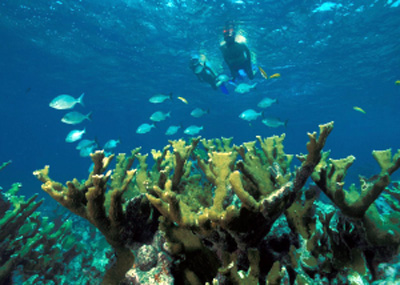 |
Among the four marine ecosystems protected by the park is a significant portion of the world’s third-longest living coral reef, making the park an ideal place for visitors to interact and observe the mesmerizing aquatic wildlife.
Since coral reefs are such an asset to the subtropical environment in Florida, there has been an enormous push towards spreading the message of conservation and protection of coral reefs.
Biscayne National Park has become a focal point for organizations such as the Department of Environmental Protection’s (DEP) Coral Reef Conservation Program (CRCP) and the Southeast Florida Coral Reef Initiative (SEFCRI), to promote coral reef awareness.
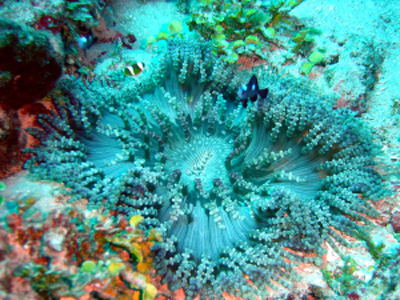 |
Sea anemones thrive off of the nutrition and stability that the coral reef provides (Photo courtesy of the National Park Service). |
“The DEP-CRCP is holding free monthly identification classes on Reef Fish, Reef Corals, Marine Invertebrates and Professional Association of Diving Instructors (PADI) Project Aware to celebrate the International Year of the Reef Foundation,” stated Christopher Boykin, the Awareness and Appreciation Project Coordinator for the Florida Department of Environmental Protection Coral Reef Conservation Program.
The International Year of the Reef is a global campaign intended to raise awareness about the importance of conserving coral reefs while motivating people to help contribute to the cause of coral reef protection, whether through financial donations, organized cleanups, or educational programs.
The International Year of the Reef campaign began 11 years ago and was a response to the growing forces, such as an increased awareness of global warming, that were damaging the reefs worldwide. Since its commencement, the organization has not just focused on disseminating the importance of reef conservation, but has also promoted further research and education internationally.
| Coral reefs attract all kinds of aquatic wildlife by providing them with nutrition and protection (Photo courtesy of the National Park Service). |
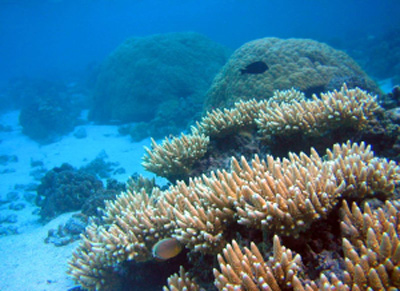 |
Presently, the IYOR has several hundred organizations in countries around the world participating in the campaign, and they are working together to conduct further scientific research in order to influence public policies that encourage environment protection.
Marine life education is engrained in native Floridians at an early age, and coral reef preservation is heavily emphasized in schools throughout Florida’s southeast region. With the promotion of the International Year of the Reef, educators and Floridians alike have become even more involved in the movement to help protect and save the reefs.
“Residents, local teachers and even visitors have contacted our office asking how they can help. The public recognizes how fortunate we are to have this extensive reef system in Florida and they are eager to learn more about coral reefs and protect them,” said Boykin.
Both visitors and residents flock to the vast Florida coastline, and participate in aquatic-centered activities such as diving and snorkeling. Those who have been fortunate enough to enjoy Florida’s incredible marine life understand the importance of coral reef protection, since reefs maintain the array of fisheries so beloved by visitors.
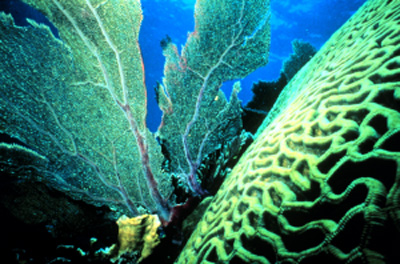 |
Brain coral and sea fans are just a few of the creatures that call the coral reef home (Photo courtesy of the Florida Keys National Marine Sanctuary) |
“Through our research, outreach and education efforts, the DEP-CRCP has found that most Florida residents support coral reef conservation. The user groups who are out there diving, fishing and boating recognize the importance of protecting this unique and vulnerable natural treasure of Florida and the United States,” said Boykin.
Special programs are being promoted by the park to educate visitors about the global mission and are certain areas are even hosting special workshops for teachers and educators to help spread the message of the campaign.
“We are holding a special teacher training workshop in late summer 2008….The training will not be limited to science teachers. We anticipate everything from essay contests in English class, to art projects to dioramas, debates and marine biology clubs with guest lecturers,” said Boykin.
With the growing emphasis to protect the environment and the realization of the damage that global warming is causing for the planet’s ecosystems, reef protection is a popular topic since so the livelihood of so much marine life depends on the reef.
| Lionfish, native to the South Pacific, are occasionally sighted in the waters of Biscayne National Park (Photo courtesy of Tobias Biehl). |
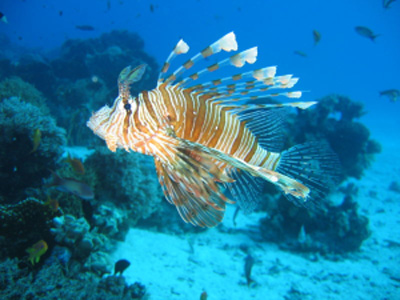 |
There are so many ways to get involved with the campaign for coral reef conservation, and a great place to start is at Biscayne National Park, where participating in the celebration of the International Year of the Reef is both fun and fulfilling for adults and children.
If You Go
Contact Information
Phone: 305-230-PARK (305-230-7275)
Directions:
The beginning portion of the park can be reached from either the Florida Turnpike or from U.S. 1.
- If you are traveling from the North, take the Florida Turnpike south to Exit 6 (Speedway Boulevard). Turn left from the exit ramp and continue south to SW 328th Street (North Canal Drive). Turn left and continue to the end of the road. The Park is approximately five miles, and the entrance is on the left.
- If traveling from U.S. 1, drive south to Homestead. Turn left on SW 328th Street (North Canal Drive), and continue to the end of the road. The park is approximately nine miles, and the entrance is on the left.
- If you are traveling from the South, take U.S. 1 (Overseas Highway), north to Homestead. Turn right on SW 328th Street (North Canal Drive, which is the first light after Florida Turnpike entrance), and continue to the end of the road. The entrance to the park approximately nine miles on the left.
Hours of Operation:
- The water portion of Biscayne National Park is open 24 hours a day, but Adams Key (accessible only by boat) is a day use area only.
- The Convoy Point, which is where the park’s headquarters and visitor center are located, is open daily from 7 a.m. to 5:30 p.m., and the Dante Fascell Visitor Center is open daily from 9 a.m. to 5 p.m.
For more information on the International Year of the Reef, and participating areas visit the International Year of the Reef website at http://www.iyor.org.

Comments are Closed